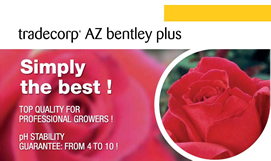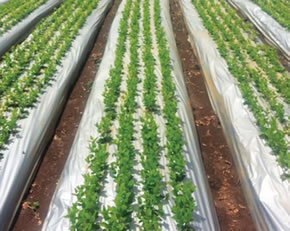Featured Past Articles
They say that our crops are exposed to about 240 economically important pests and diseases and Downy mildew happens to be that disease affecting the many varieties of roses grown in Kenya today.
Downy Mildew is one of the major disease challenges to the floriculture industry whose control budget is about 20% of the total pesticide value. It occurs rapidly and the effects on the quality of roses is irreversible and the loss is irreparable.
What is downy mildew?
Downy mildew is a fungal disease that mainly causes destruction of leaves leading to massive defoliation. It’s a disease of moist cloudy conditions which is active only in cool and damp conditions that causes severe and rapid defoliation - can defoliate an entire plant in 2 days. The causal organism being Peronospora sparsa, a fungus that is highly destructive and fast spreading in roses.
Downy mildew affects different parts of the plant such as the leaves, stems, peduncles, calyxes and petals hence affecting young growth which may wilt. The leaf symptoms are Irregular-shaped, purple spots that form on the upper leaf surface while light grey brown spore masses form on the underside of the leaf. The brown spots look like injuries caused by a chemical spray. Older leaves infected first and then progressively younger leaves follow.
The fungus under unfavourable conditions, survives as mycelium or oospores in or on plant parts without showing disease signs but upon favourable conditions, mycelium growth resumes among the plant cells to produce oospores (fungal seeds) within 3 days. Oospores are spread by wind or water and germinate on leaf or other plant surface. Unlike powdery mildew spores, which are spread by the wind, downy mildew is spread by splashing water. Some farms carry over the disease from bud wood taken from infected stock during propagation.
How do you control downy mildew?
That’s the question in some of if not all grower’s mind and the many who are able to control it are able to identify the disease and it’s stages, looking for symptoms of early infection on older leaf tissue before chlorosis develops and identifying the symptoms before the disease reaches flowers, understanding the biology, the predisposing factors, monitoring the disease’s progress which helps in predetermining the disease onset and coming up with an appropriate chemical intervention. Controlling the disease can be summarized into;
Field and Crop Hygiene: This involves maintaining greenhouse cleanliness, removing infected plant tissues & fallen plant debris well away from your production area since spores may survive and be viable on dried fallen leaves for as long as one month. Cultural Practices which may include opening up the crop by pruning, improving greenhouse air ventilation by opening up vents especially at sunset when the greenhouse air is warm and moist while outside air is cool and drier. It is critical to keep relative humidity below 85% to decrease sporulation on infected plants and stop germination of spores on healthy plants. Humidity should not remain above 85% for more than 3 hours
Chemical Intervention: This is the last but not least method of controlling downy mildew. Crop protection products safeguard harvest yields, and thereby ensure that the flowers are of high quality. Many products give excellent control when used as preventive treatments rather than curative treatments. Growers should categorize the fungicides into Penetrant, Protectant, Post-infection, eradicant, Immune system enhancement etc. Another notable factor is the Spectrum of activity, Resistance concerns and IPM management coupled with crop safety.
There is need to position the chemical so as to interrupt the disease progress at the right point as well as the correct application which is critical.
BASF knows the threat of downy mildew and is constantly innovating new solutions that can stand the test of twenty first century grower demands and challenges. BASF has introduced Orvego® 525SC whose activity is superior in Downy mildew control.
Orvego® 525SC is a versatile element for your downy mildew spray program that maximizes the marketable yields of your crops – for all markets worldwide. It has dimethomorph and Initium™ that stops the flow of energy in the fungus like a valve stops the flow of fuel in a pipe as well as no cross resistance observed with other chemical classes. Initium is an innovation breakthrough by BASF and forms a very vital tool for resistance management as it’s in a class of its own.
The parting shot is that the damage caused by Downy mildew is more or less dependent on the skill and experience of the grower who takes customer satisfaction a notch higher.
Joseph Maina is the BASF Ornamentals Manager - Kenya
Briefly discuss Matt Fryer (Background and Managing Director Arysta LifeScience East Africa)
 I was born into a farming community in South Africa, and my love for farming, nature and the outdoors started as far back as I can remember.
I was born into a farming community in South Africa, and my love for farming, nature and the outdoors started as far back as I can remember.
After completing my BSC Agric in 2002, I went on to work for a small crop protection company, Gap Chemicals, based in Kwazulu Natal and focused on Sugarcane. The small size of the company resulted in me being exposed to all aspects of running a successful business and this quickly revealed yet another passion I have for customer service.
In 2008 I joined Arysta LifeScience South Africa as a Key Account Manager and in addition to my deliverables I took on active roles in the S&OP process, demand planning and had a short stint of looking after the Southern Africa export business. In 2014 I was appointed Commercial Manager for South Africa, mainly as a support role to the Commercial Director, and was responsible for forecasting, pricing, stock distribution and allocation. In early 2015 I was offered the incredible opportunity to move to Nairobi. Having spent my entire career being based in South Africa, it was an easy decision to make to move here and embark on this new leadership challenge.
 We cannot close our eyes to the problems the world faces. At Agrichem Africa Limited® we believe that business must be part of the solution. But to be so, business will have to change. Sustainable, equitable growth is the only acceptable business model.
We cannot close our eyes to the problems the world faces. At Agrichem Africa Limited® we believe that business must be part of the solution. But to be so, business will have to change. Sustainable, equitable growth is the only acceptable business model.
Agrichem Africa Limited® works to create a better future every day, with brands and services that help people feel good, look good and get more yields out of the harvest. Our first priority is to our consumers – then farmers, employees, suppliers and communities. When we fulfil our responsibilities to them, we believe that our shareholders will be rewarded.
Agrichem Africa Limited® has, from its origins, been a purpose-driven company. Today our purpose is to make sustainable farming a common activity. This means helping to build an industry where everyone lives well and within the natural limits of the planet:
Kenya Flower Council (KFC) is a voluntary association of independent growers and exporters of cutflowers and ornamentals, formed in 1996, with the aim of fostering responsible and safe production of cut flowers in Kenya with due consideration of workers welfare and protection of the environment.
Against this background the KFC has become a common platform for industry representation, promotion and compliance to pertinent local and international standards, deemed necessary to secure markets.
 Tradecorp has been helping the flower industry in Kenya for the past 15 years in maximizing yields and plant quality with its superior range of micronutrients & speciality fertilizers. These products are designed to enhance soil health, nutrient availability and fertilizer performance. Founded in 1985 in Spain, the company has a broad experience in crop nutrition.
Tradecorp has been helping the flower industry in Kenya for the past 15 years in maximizing yields and plant quality with its superior range of micronutrients & speciality fertilizers. These products are designed to enhance soil health, nutrient availability and fertilizer performance. Founded in 1985 in Spain, the company has a broad experience in crop nutrition.
This was stated by Mr. Vincent Claux, the Technical director of Europe and Sub- Saharian Africa, during a seminar held for flower growers in Kenya in April 2016. During the seminar held in Naivasha, Vincent took the growers through their range of solutions for the sector. ‘’We are a one stop shop for all your nutritional problems’’, he said. Tradecorp solutions include micronutrients such as Fe, Mn, Zn, Cu, B, Mo, & Co.
 Hydroponics is fancy name for growing plants in soilless media with a nutrient solution. Humans started dabbling in hydroponics as far back as 1670 when it was discovered that plants grew better in ‘dirty’ water than in distilled water. Hydroponics became a great way to identify the essential nutrients for plant growth, and the minimum and maximum levels required. Hydroponics gives complete control on nutrient availability.
Hydroponics is fancy name for growing plants in soilless media with a nutrient solution. Humans started dabbling in hydroponics as far back as 1670 when it was discovered that plants grew better in ‘dirty’ water than in distilled water. Hydroponics became a great way to identify the essential nutrients for plant growth, and the minimum and maximum levels required. Hydroponics gives complete control on nutrient availability.
In Kenya hydroponics is relatively new, becoming popular in the last 15-20 years. The initial move from soil to hydroponics was prompted by the banning of the soil fumigant, methyl bromide, and a general decline in production over time in plants grown in the same soil. It was soon discovered that managed well, hydroponics could be more productive, with better quality and less disease pressure. Hydroponics is generally restricted to high value crops, like roses, but more and more we are seeing tomatoes, capsicum, herbs, leafy vegetables and summer flowers in hydroponics.
 Has to Market Your Business
Has to Market Your Business
I FTEX has traditionally been a very popular exhibition to market your products, services and business. With advances in social media marketing and Internet technology, like webinars, Google hangouts and video conferencing, the value and benefits of marketing via trade fair comes up. Though technology is changing marketing at a rapid pace, there are several benefits from having exhibit presence at a trade show. These six key benefits are why your business must have IFTEX Exhibition marketing presence:
1.IFTEX Creates Lasting Impressions If Done Right
The main purpose of IFTEX is to showcase a wide variety of options for attendees and business to engage and interact with each other. With a well-designed trade show booth that draws attendees’ attention, a few promotional items, a contest opportunity with giveaways and sales collateral, you will have a wellrounded booth experience that leaves an impression with a prospective customer for months. Consider having attendees enter a drawing by submitting a business card or completing an action on social media. These types of promotions serve dual purposes: increasing engagement and capturing potential contact information as well.


